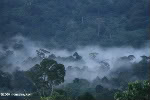To save species around the world zoos say deeper emission cuts are needed than governments are currently proposing. Over 200 zoos worldwide have signed a petition calling on governments to set the target of atmospheric carbon below 350 parts per million (ppm) far lower than most government targets.
The signatories, each a member of the World Association of Zoos and Aquariums (WAZA), argue the target is necessary to prevent a mass extinction, which some ecologists warn is already occurring.
“From seahorses to golden-headed lion tamarins, zoos and aquariums play a crucial role in breeding endangered species for reintroduction into the wild. However, the climate change threat to the natural world is so severe that we’re rapidly losing suitable habitats for these species,” explains Paul Pearce-Kelly in a press release from WAZA. Pearce-Kelly is Senior Curator at ZSL and Chair of the WAZA Climate Change Task Force.
The target of 350 ppm, which is also the target of a number of high profile environmental groups, was agreed to at a meeting in July by scientists and conservationists, including conservation luminary Sir David Attenborough. The researchers agree that allowing carbon to stay above 350 ppm—as of March of this year it was at 387 ppm—will cause irreversible damage to the world’s coral reefs. Currently most government have set a target of 450 ppm.
“The urgent protection of ecosystems, which act as natural carbon sinks, is vital if humanity is to avoid the fate of runaway climate change. Our only hope is that world leaders respond to this reality and take the appropriate action,” says WAZA President, Dr. Mark Penning, adding that “climate change is not just another issue for the zoo and aquarium community to address, it is the chess board which will determine the outcome of all our conservation efforts.”
The zoos warn that if atmospheric emissions aren’t lowered below 350 ppm many of the world’s species may only survive in zoos—if they survive at all.
Related articles
Declaration calls for more wilderness protected areas to combat global warming

(11/11/2009) Meeting this week in Merida, Mexico, the 9th World Wilderness Congress (WILD9) has released a declaration that calls for increasing wilderness protections in an effort to mitigate climate change. The declaration, which is signed by a number of influential organizations, argues that wilderness areas—both terrestrial and marine—act as carbon sinks, while preserving biodiversity and vital ecosystem services.
Global warming threatens desert life
(11/09/2009) There have been numerous studies showing how climate change is impacting a variety of environments—from the Arctic to coral reefs to alpine—but how could a warmer world damage deserts, already the world’s warmest and driest environments?
Present day tropical plant families survived in warmer, wetter tropics 58 million years ago

(10/18/2009) Fifty eight million years ago the tropical rainforests of South America shared many similarities with today’s Neotropical forests, according to research published in the Proceedings of the National Academy of Sciences. Looking at over 2,000 fossils in Colombia from one of the world’s largest open pit coal mines, scientists were able to recreate for the first time the structure of a long vanished rainforest. One inhabited by a titanic snake, giant turtles, and crocodile-like reptiles.
Will tropical trees survive climate change?, an interview with Kenneth J. Feeley

(09/24/2009) One of the most pressing issues in the conservation today is how climate change will affect tropical ecosystems. The short answer is: we don’t know. Because of this, more and more scientists are looking at the probable impacts of a warmer world on the Earth’s most vibrant and biodiverse ecosystems. Kenneth J. Feeley, tropical ecologist and new professor at Florida International University and the Center for Tropical Plant Conservation at the Fairchild Tropical Botanic Garden, is conducting groundbreaking research in the tropical forests of Peru on the migration of tree species due to climate change.
Photos: hundreds of new species discovered in Himalayan region, threatened by climate change

(08/10/2009) Scientists from a variety of organizations have found over 350 new species in the Eastern Himalayas, including a flying frog, the world’s smallest deer, and a gecko which has walked the earth for 100-million-years, according to a new report by the World Wildlife Fund (WWF). The report, entitled Where World’s Collide, warns that these rare biological treasures, as well as numerous other species, are threatened in the Eastern Himalayas by climate change.
Climate change could devastate lizards in the tropics

(03/04/2009) With help from data collected thirty years ago, scientists have discovered that tropical lizards may be particularly sensitive to a warming world. Researchers found that lizards in the tropics are more sensitive to higher temperatures than their relatives in cooler, yet more variable climates. “The least heat-tolerant lizards in the world are found at the lowest latitudes, in the tropical forests. I find that amazing,” said Raymond Huey, lead author of a paper appearing in the March 4 Proceedings of the Royal Society B.
Global warming may doom emperor penguins to extinction
(01/27/2009) Disappearing sea ice around Antarctica may put emperor penguins at risk of extinction within the next century, warn scientists writing in this week’s Proceedings of the National Academy of Sciences.
Symposium tackles big question: how many species will survive our generation
(01/16/2009) Nine scientists dusted off their crystal balls Monday at the National Museum of Natural History in Washington DC, weighing in on the future of the world’s tropical forest. Despite the most up-to-date statistics, prognosis for the future of tropical forests varied widely. In the last few years a schism has occurred among biologists regarding the future of the tropics. No tropical scientist denies that rainforests and the species which inhabit them face unprecedented threats; neither do they argue that some of these forested regions and species will likely not survive the next fifty years. What has sparked debate, sometimes heated, is how bad will is it really? When the dust settles, what percentage of species will survive and how much forest will remain?
What is the greatest threat to rainforests: habitat destruction or climate change?

(01/13/2009) A symposium from the Smithsonian Institution meant to debate the level of threat by deforestation posed to the tropics shifted topic slightly near its end as scientists began to discus which was the most significant threat for rainforests and the species that inhabit them: habitat destruction or climate change?